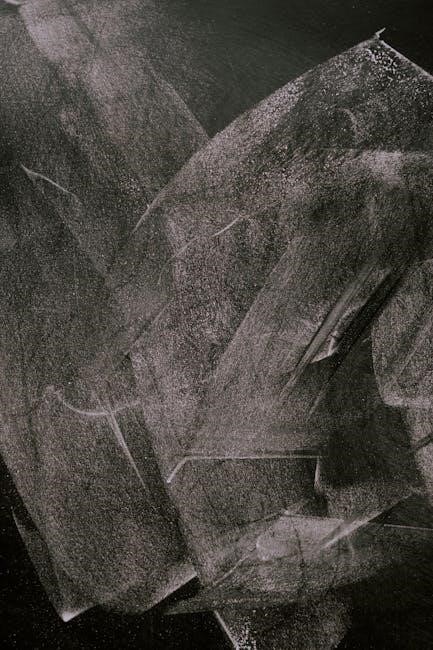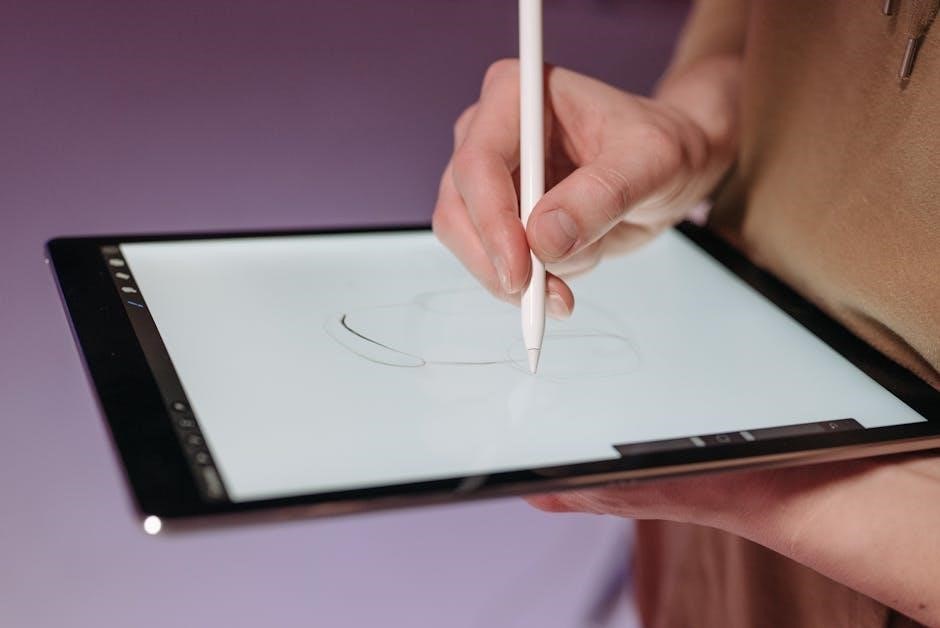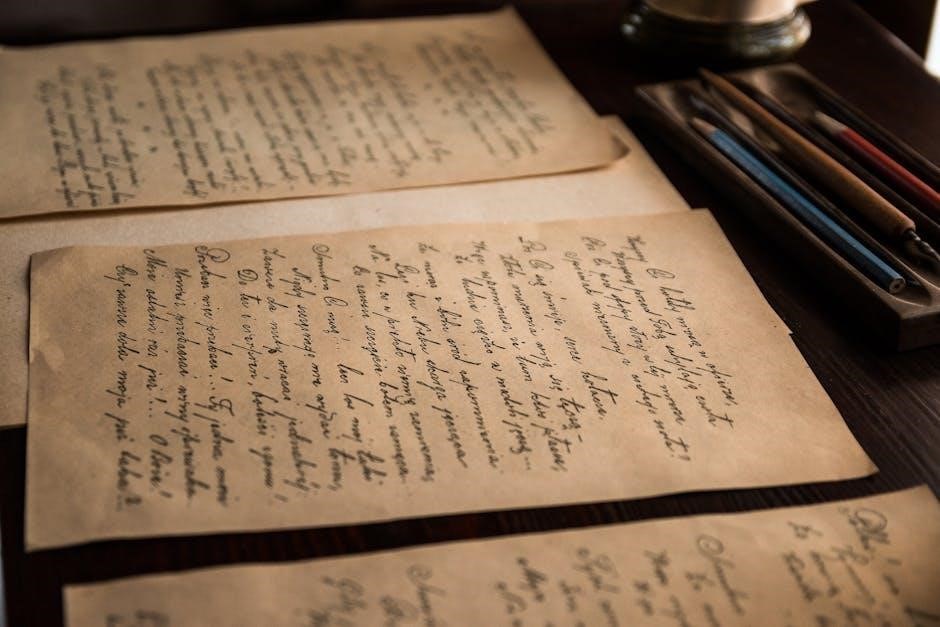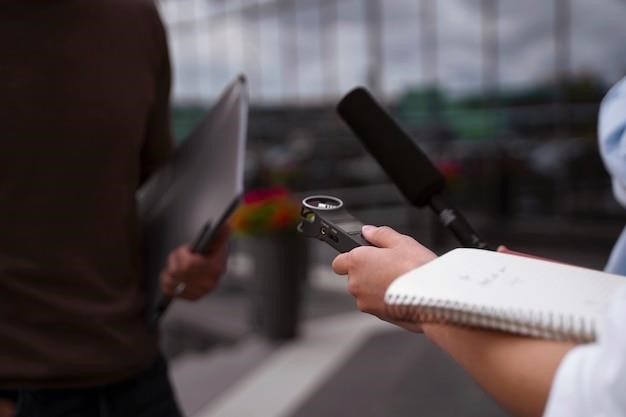Sylvan Barnet’s guide offers practical advice for writing about art, emphasizing clear description, thoughtful analysis, and contextual understanding. It empowers readers to engage deeply with artworks and express their insights effectively.

Overview of Sylvan Barnet’s Approach to Art Writing
Sylvan Barnet’s approach to art writing emphasizes clarity, accessibility, and depth. He advocates for moving beyond jargon, encouraging writers to engage with artworks thoughtfully and describe them vividly. Barnet’s method is structured to guide both novices and experienced writers, offering practical strategies to analyze and interpret art effectively. His approach balances technical art historical terms with everyday language, ensuring that readers can connect with the subject matter. By focusing on observation, description, and contextual analysis, Barnet helps writers avoid common pitfalls like overcomplication or vague generalizations. His guidance fosters a deeper understanding of art while empowering writers to express their insights confidently and clearly.
The Importance of Context in Art Analysis
Context plays a crucial role in art analysis, as it provides the historical, cultural, and social framework necessary for understanding an artwork’s meaning. Sylvan Barnet emphasizes that without context, interpretations may lack depth or accuracy. The time period, artist’s intentions, and cultural norms all influence how a piece should be viewed and interpreted. For instance, symbols or themes in a work may carry specific meanings that are only apparent when considered within their historical or cultural setting. Context also helps connect artworks to broader art historical movements, offering a richer understanding of their significance. By considering the circumstances surrounding an artwork’s creation and reception, writers can provide more nuanced and insightful analyses, avoiding superficial or misleading interpretations.
Key Principles for Effective Art Writing
Sylvan Barnet’s guide outlines essential principles for writing about art, focusing on clarity, precision, and engagement. He advocates for a structured approach, beginning with careful observation and detailed description. Writers should avoid vague language, instead using specific terms to convey their analysis. Barnet also stresses the importance of a clear thesis statement to guide the essay. Objectivity is key, as personal opinions should be supported by evidence from the artwork itself. Additionally, he emphasizes the value of revising and editing to refine ideas and ensure coherence. By adhering to these principles, writers can produce insightful, well-supported, and engaging analyses that resonate with readers. Barnet’s approach encourages a balance between technical analysis and accessible writing, making art criticism both informative and enjoyable for a broad audience.

Understanding Art: The Foundation of Writing
Understanding art is the cornerstone of writing about it. Barnet’s guide emphasizes observation, description, and analysis as essential tools for building a strong foundation in art criticism, fostering meaningful engagement with artworks and clear communication of ideas.
Developing Observation Skills for Art Analysis
Developing strong observation skills is essential for effective art analysis. Barnet emphasizes the importance of careful, detailed examination of artworks, encouraging readers to slow down and truly “see” the artwork. By training the eye to notice elements like line, shape, color, and composition, writers can build a solid foundation for analysis. Practical exercises, such as describing artworks in detail or comparing similar works, help refine these skills. Barnet also suggests using tools like magnification or multiple viewpoints to uncover subtle details. Cultivating patience and a systematic approach ensures that no aspect of the artwork is overlooked, enabling deeper insights and more nuanced writing. This process not only enhances analytical abilities but also fosters a greater appreciation for the art itself.
Learning to Describe Art Effectively
Learning to describe art effectively is a cornerstone of art writing, as outlined in Sylvan Barnet’s guide. Barnet stresses the importance of using clear, precise language to convey the visual elements of an artwork. He encourages writers to avoid vague terms and instead focus on specific details, such as color, texture, and composition. By practicing descriptive writing, readers can develop the ability to translate their observations into words that accurately reflect the artwork. Barnet also emphasizes the value of comparing and contrasting elements within a piece to highlight its unique qualities. Effective description not only enhances the reader’s understanding but also ensures that the writer’s analysis is grounded in tangible, observable features of the art. This skill is foundational for building compelling and insightful art criticism.
The Role of Art History in Informing Your Writing
Art history plays a pivotal role in shaping the depth and accuracy of art writing, as it provides the necessary context and background for understanding artworks. By studying art history, writers can identify historical styles, cultural influences, and artistic movements that shape an artist’s work. This historical understanding allows for a more informed analysis of themes, motifs, and symbols present in an artwork. Sylvan Barnet emphasizes the importance of referencing art history to uncover the intentions and meanings behind a piece. Utilizing museum catalogs, art historical texts, and online resources can offer insights into the artist’s techniques, inspirations, and the cultural milieu in which they worked. Incorporating this knowledge enriches the writer’s interpretation and provides readers with a comprehensive understanding of the artwork’s significance. Accurate historical references also ensure that the analysis remains credible and well-founded, enhancing the overall quality of the writing.

Elements of Art and Principles of Design
The elements of art—line, shape, form, color, texture, and space—and the principles of design, such as balance, proportion, rhythm, contrast, and unity, guide artistic composition.
Line, Shape, and Form in Art
Line, shape, and form are foundational elements in art, guiding composition and expression. A line can vary in width, direction, and texture, conveying movement or emotion. Shapes, whether geometric or organic, define spaces and create harmony or tension. Form refers to three-dimensional objects or illusions of depth. Artists use these elements to direct the viewer’s eye and communicate themes. Barnet emphasizes observing how lines define contours, shapes create stability, and forms suggest volume. Understanding these basics helps writers describe artworks effectively, capturing their visual and emotional impact. By focusing on these elements, one can analyze how artists achieve balance and rhythm, making their compositions dynamic and meaningful. This foundation is crucial for articulating insights about artistic techniques and intentions.
Color and Contrast in Artistic Composition
Color and contrast are powerful tools in artistic composition, influencing mood, emphasis, and visual harmony. Barnet highlights how color can evoke emotions and guide the viewer’s attention. Warm colors like red and orange often convey energy, while cool colors like blue and green create calm. Contrast, achieved through color, value, or saturation, enhances visual interest and defines forms. Artists use color harmony to balance compositions, whether through complementary, analogous, or monochromatic schemes. Barnet advises writers to describe color accurately and explore its emotional and symbolic roles. By analyzing color choices, one can uncover an artist’s intent and the overall impact of the work. Understanding color theory and contrast enables writers to articulate how artworks engage and communicate effectively.
Balance, Proportion, and Rhythm in Art
Barnet emphasizes balance, proportion, and rhythm as fundamental elements in artistic composition. Balance refers to the distribution of visual weight, achieved through symmetry or asymmetry. Proportion involves the relationship of parts to the whole, guiding the viewer’s perception of scale and harmony. Rhythm, created through repetition and pattern, adds dynamic energy to a work. These principles work together to create cohesive and engaging compositions. Writers analyzing art should consider how these elements contribute to the overall impact, whether through stable balance, proportional accuracy, or rhythmic movement. By discussing these aspects, writers can reveal an artist’s mastery of composition and the emotional resonance of their work. Barnet encourages detailed observation to effectively communicate how these elements enhance the artwork’s meaning and visual appeal.

Approaches to Analyzing Art
Barnet introduces structured methods for analyzing art, focusing on formal, iconographic, and contextual approaches. These techniques help writers deeply understand and effectively communicate an artwork’s meaning and significance.
Formal Analysis: Focus on Composition and Style
Formal analysis involves examining an artwork’s composition and style to uncover its visual and structural elements. This method focuses on aspects like line, shape, color, and balance, which collectively create the artwork’s aesthetic and emotional impact. By studying composition, one can explore how elements are arranged to guide the viewer’s eye and create harmony or tension. Style refers to the distinctive characteristics of the artist or period, such as brushstroke techniques or color palettes. Together, these elements provide insights into the artist’s intentions and the artwork’s significance, allowing for a deeper understanding and appreciation of its visual language and artistic expression.
Iconographic Analysis: Understanding Symbols and Themes
Iconographic analysis focuses on deciphering the symbols, themes, and hidden meanings within artworks. This approach examines how visual elements convey cultural, religious, or personal narratives. By identifying and interpreting symbols, viewers can uncover the deeper messages embedded by the artist. Themes often reflect broader ideas, such as morality, power, or identity, while symbols may carry specific meanings tied to their historical or cultural context. Understanding these elements requires research into the artist’s intentions, the era’s traditions, and the audience’s perspective. Iconographic analysis enriches art interpretation by revealing layers of significance that might otherwise remain unnoticed, connecting the artwork to its cultural and social roots. This method encourages viewers to look beyond the surface, engaging with the artwork’s intellectual and emotional depth. It bridges the gap between visual representation and conceptual understanding, making art more accessible and meaningful.
Contextual Analysis: The Role of Historical and Cultural Context

Contextual analysis explores how historical and cultural contexts shape the meaning of artworks. By examining the time and place in which a piece was created, viewers can uncover the social, political, and religious influences that informed the artist’s vision. This approach emphasizes understanding the artist’s intentions and the audience’s perspective within their specific historical framework. Cultural context includes traditions, beliefs, and values that define a society, while historical context involves events and conditions that influenced the artwork’s creation. Without this contextual understanding, interpretations may remain superficial or misinterpreted. Contextual analysis bridges the gap between the past and present, enabling a deeper appreciation of the artwork’s significance and relevance. It highlights how art reflects and engages with the world around it, making it a vital tool for meaningful interpretation.

Writing About Specific Artworks
This section provides strategies for analyzing specific artworks, emphasizing clear description, thoughtful interpretation, and effective communication of insights. Barnet’s approach ensures depth and clarity in analysis.
How to Write a Clear and Concise Art Analysis
Writing a clear and concise art analysis requires a structured approach. Begin with a strong thesis statement that guides your interpretation. Describe the artwork objectively, focusing on specific elements like composition, color, and form. Use formal analysis to examine the artist’s techniques and how they contribute to the overall meaning. Incorporate relevant art historical context to deepen your analysis. Avoid vague language; instead, use precise terminology to convey your ideas. Organize your essay with a logical flow, ensuring each paragraph supports your thesis. Finally, revise your work to refine your arguments and eliminate redundancy, ensuring your analysis is both insightful and accessible to readers.
Strategies for InterpretingAbstract and Contemporary Art
Strategies for Interpreting Abstract and Contemporary Art

Interpreting abstract and contemporary art requires a nuanced approach. Begin by understanding the artist’s intent and historical context. Analyze visual elements like color, texture, and composition to uncover hidden meanings. Consider the emotional and conceptual themes the artwork conveys. Engage with the piece’s cultural and social relevance, as contemporary art often reflects current issues. Use interpretation techniques such as formal analysis or iconography to decode symbols. Practice critical thinking to connect personal experiences with the artwork’s message. Research the artist’s statements and previous works to gain deeper insights. Finally, embrace ambiguity and multiple interpretations, as abstract and contemporary art often resist a single, definitive meaning.
Writing About Sculpture, Photography, and Other Media
Writing about sculpture, photography, and other media requires attention to their unique qualities. For sculpture, focus on its three-dimensional form, texture, and how it interacts with space. Photography demands an analysis of composition, lighting, and the captured moment. When addressing other media, such as installations or digital art, consider their conceptual underpinnings and audience interaction. Use descriptive language to convey the tactile and visual elements of the work. Research the artist’s intent and the medium’s historical context to enrich your analysis. Be mindful of the technical aspects specific to each medium, such as the materials used in sculpture or the printing process in photography. This approach ensures a comprehensive and insightful discussion of diverse artistic forms.

Research and Resources for Art Writing
Effective research techniques enhance accuracy and depth in art writing. Utilize credible sources like museum catalogs and academic texts to gather reliable information and context for analysis.
Using Museum Catalogs and Art Historical Texts
Museum catalogs and art historical texts are invaluable resources for art writers, offering detailed analyses, artist biographies, and contextual insights. These sources provide authoritative information, helping writers craft informed and nuanced analyses. By referencing these materials, writers can gain a deeper understanding of artistic movements, styles, and historical contexts, enriching their writing with accuracy and depth. Additionally, these texts often include high-quality images and expert commentary, which are essential for conducting thorough research. Leveraging these resources ensures that writers can produce well-researched and credible art criticism, making them indispensable tools in the process of writing about art effectively.
Effective Use of Online Resources for Art Research
Online resources have transformed art research, offering unparalleled access to high-quality images, scholarly articles, and interactive tools. Museum websites, online databases, and academic platforms provide extensive collections and detailed analyses. Effective use of these resources involves employing specific search terms and operators like Boolean logic to refine results. Utilizing digital archives and virtual exhibitions can deepen understanding of artistic styles and historical contexts. Additionally, online forums and scholarly networks facilitate collaboration and knowledge sharing. By mastering these tools, writers can efficiently gather accurate information, enhancing the depth and credibility of their art analysis. Leveraging online resources strategically ensures well-informed and engaging writing about art.
How to Cite Sources in Art Writing
Accurate citation is crucial in art writing to acknowledge sources and maintain academic integrity. Common citation styles like MLA, APA, or Chicago are often used, with specific formats for artworks, books, and online resources. For example, citing a painting includes the artist’s name, title, date, and location. Properly attributing sources strengthens credibility and avoids plagiarism. Tools like citation generators and style guides can help ensure accuracy. Consistency in formatting is key, whether referencing museum labels, scholarly articles, or online databases. By carefully documenting sources, writers provide readers with clear pathways to explore topics further. Barnet emphasizes the importance of precise attribution to respect intellectual property and uphold scholarly standards in art writing.

Exercises and Practices for Improving Art Writing
Regular practice in analyzing and describing artworks, along with peer feedback, helps refine writing skills and clarity. Exercises like timed descriptions and stylistic studies enhance precision and fluency.
Writing Descriptions of Artworks
Writing clear and engaging descriptions of artworks is a fundamental skill in art writing. Start by carefully observing the artwork, noting details such as color, composition, and form. Use precise language to convey your observations, avoiding vague terms. Practice describing different types of art, from paintings to sculptures, to refine your ability to capture their unique qualities. Pay attention to the artist’s use of elements like line, shape, and texture, and how these contribute to the overall effect. Avoid overly technical jargon unless necessary, aiming for clarity and accessibility. Regular practice will help you develop a keen eye and the ability to translate visual experiences into words effectively. This exercise is essential for building confidence and precision in your art writing.
Practicing Formal and Informal Art Criticism
Practicing formal and informal art criticism is essential for refining your writing skills. Formal criticism involves structured, analytical responses, often using specific art historical terms and concepts. It requires close observation, critical thinking, and the ability to articulate nuanced interpretations. Informal criticism, on the other hand, allows for more personal and conversational reflections, making it accessible to broader audiences. Both approaches demand a deep understanding of the artwork and its context. By practicing these methods, you can develop versatility in expressing your ideas and engage more effectively with different readers. Regularly writing critiques will help you refine your voice, sharpen your analytical skills, and communicate your insights with clarity and confidence, whether in academic or casual settings.
Engaging in Peer Review and Editing
Engaging in peer review and editing is a vital step in refining your art writing. Peer review allows others to provide constructive feedback on your work, helping you identify strengths and areas for improvement. Editing, whether self-done or by others, ensures clarity, precision, and coherence in your writing. It’s an opportunity to refine your ideas, strengthen arguments, and polish your language. Peer feedback can offer fresh perspectives, revealing insights you may not have considered. By embracing this collaborative process, you can enhance the quality of your writing and develop a more objective eye for critique. Regular peer review and editing not only improve your current work but also contribute to your growth as a writer and thinker about art.
Barnet’s guide equips writers with essential tools for analyzing and expressing art effectively, emphasizing clear description, thoughtful analysis, and continuous practice to refine their craft and deepen understanding.
Final Tips for Becoming a Confident Art Writer
To become a confident art writer, embrace consistent practice and a willingness to learn. Start by developing a keen eye for detail, as meticulous observation is the foundation of compelling art analysis. Practice writing regularly, experimenting with different styles and approaches to find your voice. Seek feedback from peers or mentors to refine your work and gain new perspectives. Stay curious about various art forms, historical periods, and cultural contexts to broaden your understanding. Be open to revision, recognizing it as an essential part of the writing process. Use clear and concise language to convey your ideas effectively. Finally, stay inspired by engaging with artworks, reading critiques, and exploring new ideas. With dedication and persistence, you’ll grow into a skilled and confident art writer.
The Ongoing Process of Learning and Growth
Writing about art is a journey that requires continuous learning and growth. Regularly expose yourself to diverse artistic styles and periods to expand your knowledge and critical thinking skills. Engage with contemporary art to stay informed about current trends and debates. Read extensively, including art criticism, theory, and historical texts, to deepen your understanding. Reflect on your own writing, identifying areas for improvement and experimenting with new approaches. Participate in discussions with fellow art enthusiasts and writers to gain fresh insights and perspectives. Embrace challenges as opportunities to refine your skills and explore new ideas. By committing to lifelong learning, you’ll enhance your ability to analyze and communicate the significance of art effectively.



